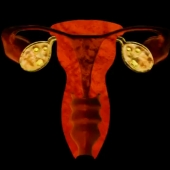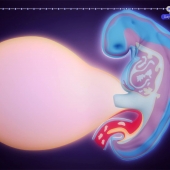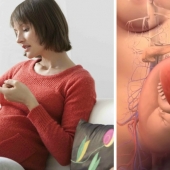Fertilization is the epic story of a single sperm facing incredible odds to unite with an egg and form a new human life. It is the story of all of us. During sexual intercourse, about 300 million sperm enter the vagina. Soon afterward, millions of them will either flow out of the vagina, or die in its acidic environment. However, many survive because of the protective elements provided in the fluid surrounding them.
Next, the sperm must pass through the cervix, an opening into the uterus. Usually it remains tightly closed, but here the cervix is open for a few days while the woman ovulates. The sperm swim through the cervical mucus, which has thinned to a more watery consistency for easier passage. Once inside the cervix, the sperm continue swimming toward the uterus, though millions will die trying to make it through the mucus.
Some sperm remain behind, caught in the folds of the cervix, but they may later continue the journey as a backup to the first group. Inside the uterus, muscular uterine contractions assist the sperm on their journey toward the egg. However, resident cells from the woman's immune system, mistaking the sperm for foreign invaders, destroy thousands more. Next, half the sperm head for the empty fallopian tube, while the other half swim toward the tube containing the unfertilized egg.
Now, only a few thousand remain. Inside the fallopian tube, tiny cilia push the egg toward the uterus. To continue, the sperm must surge against this motion to reach the egg. Some sperm get trapped in the cilia and die. During this part of the journey, chemicals in the reproductive tract cause the membranes covering the heads of the sperm to change. As a result, the sperm become hyperactive, swimming harder and faster toward their destination.
At long last, the sperm reach the egg. Only a few dozen of the original 300 million sperm remain. The egg is covered with a layer of cells called the corona radiata. The sperm must push through this layer to reach the outer layer of the egg, the zona pellucida. When sperm reach the zona pellucida, they attach to specialized sperm receptors on the surface, which triggers their acrosomes to release digestive enzymes, enabling the sperm to burrow into the layer. Inside the zona pellucida is a narrow, fluid-filled space just outside the egg cell membrane.
The first sperm to make contact will fertilize the egg. After a perilous journey and against incredible odds, a single sperm attaches to the egg cell membrane. Within a few minutes, their outer membranes fuse, and the egg pulls the sperm inside. This event causes changes in the egg membrane that prevent other sperm from attaching to it.
Next, the egg releases chemicals that push other sperm away from the egg and create an impenetrable fertilization membrane. As the reaction spreads outward, the zona pellucida hardens, trapping any sperm unlucky enough to be caught inside. Outside the egg, sperm are no longer able to attach to the zona pellucida. Meanwhile, inside the egg, the tightly packed male genetic material spreads out. A new membrane forms around the genetic material, creating the male pronucleus.
Inside, the genetic material reforms into 23 chromosomes. The female genetic material, awakened by the fusion of the sperm with the egg, finishes dividing, resulting in the female pronucleus, which also contains twenty-three chromosomes. As the male and female pronuclei form, spiderweb-like threads, called microtubules, pull them toward each other. The two sets of chromosomes join together, completing the process of fertilization.
At this moment, a unique genetic code arises, instantly determining gender, hair color, eye color and hundreds of other characteristics. This new single cell, the zygote, is the beginning of a new human being. And now the cilia in the fallopian tube gently sweep the zygote toward the uterus where he or she will implant in the rich uterine lining, growing and maturing for the next nine months until ready for birth.
- 8741 views













